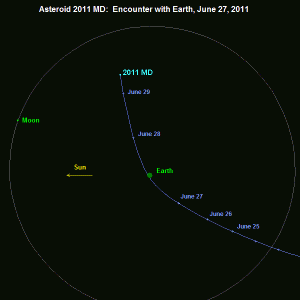The Asteroid 2011 MD, discovered on 22nd at the LINEAR near-Earth object survey in Socorro, New Mexico by the amateur Australian Astronomer, Peter Lake flew by the Earth on 27th at a close proximity of 7600 miles which is closer than most satellites. The approach did startle scientists but the prospect of the asteroid burning up in the atmosphere on entry was a relief.
The asteroid flew over the southern Atlantic Ocean, off the coast of Antarctica, during its closest approach. Though a relief now, such rocks are expected to brush Earth every once in six years. As part of the program to identify potentially hazardous objects, scientists are tracking threats like these regularly.
In February, 2011 CQ1, detected just 14 hours before approach passed even closer with a proximity of 3,400 miles making it the closest known flyby asteroid till date. You can view the images of 2011 MD captured by astronomer Tom Glinos and Wireless Beehive website here and here.
2011 MD belongs to a class of asteroids known as Apollo Asteroids that are known to be “Earth Crossers“. Their orbital semi-major axes are greater than that of the Earth (> 1 AU) and the perihelion distance (q) is less than 1.017 AU. Initially thought of as a space junk, the asteroid gave only a brief period of observability since it appeared close to the Sun during its nearest approach.
The bigger news is that a larger 400m asteroid named 2005 YU55, will make a close return on November 8. However, it is already being tracked by JPL’s NEO scientists in addition to over 75 rocks on the watch list that might make close approach to earth between now and mid-October. Asteroids like these remind us about our vulnerability to an impact and to prepare the technology to thwart such an incident if it happens.
